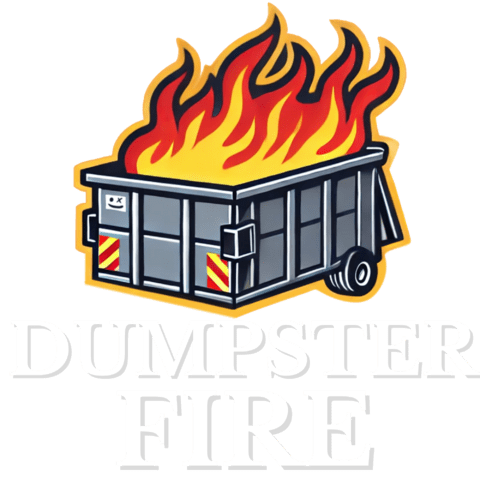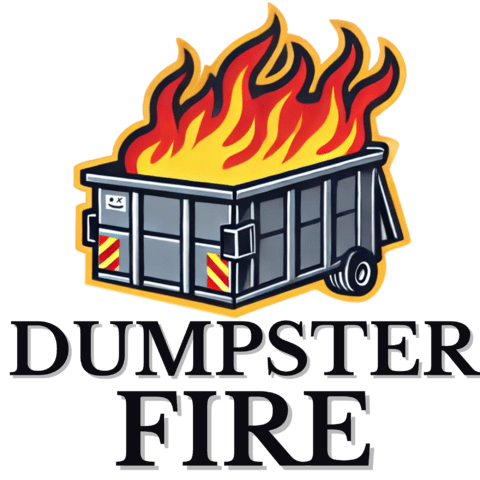What Happens to My Junk After You Haul It Away?
You’ve done it. You’ve finally cleaned out the garage, wrestled that ancient couch through the door, and waved goodbye as our white Dumpster Fire truck rumbled off into the sunset. But admit it — there’s a tiny part of you wondering: Where does all that junk actually go?
Do we sort through it by hand? Ship it to some mysterious facility? Catapult it into the Gulf of Mexico? (Don’t worry — that last one’s a no.)
Let’s walk through the real journey your junk takes after pickup — from your driveway, through the recycling and disposal process, and finally to its forever home in either Charlotte or Lee County. Spoiler: it’s less “dumpster fire,” more “organized chaos with a purpose.”
Step 1 — The Pickup: From Your Driveway to the Dumpster
It all starts when you give us a call — or, if you’re fancy, when you book online. You fill up your Dumpster Fire container with whatever life’s been collecting in your attic, shed, or backyard: busted furniture, remodeling debris, those mysterious “wires that probably go to something.”
Once you’re done, our crew arrives on schedule, hooks up the dumpster, and gets it safely loaded. We follow all Department of Transportation weight regulations (7,000 pounds per container max — we’re good, but even we can’t defy physics).
Then it’s off to one of our local disposal or recycling facilities. We don’t personally sort through each item — that’s what the licensed disposal sites are for. Our job is to get your waste from Point A to the right Point B efficiently and responsibly.
Along the way, we make sure:
- Loads are balanced and secured.
- Anything unsafe (propane tanks, paint, batteries) doesn’t sneak in.
- The right materials go to the right kind of facility.
Once your dumpster’s hauled off, it’s officially out of your hair — but its adventure is just beginning.
Step 2 — Where It All Ends Up: What Goes Where
We don’t sort junk by hand in our yard, but the facilities we use absolutely do. Southwest Florida’s waste system is built to handle just about everything you can toss into a dumpster, and each category of debris takes a slightly different route.
Let’s follow a few of the usual suspects.
Metal and Scrap Recycling
Metal has nine lives. Everything from old appliances to rusted-out swing sets can get melted down and reused. When we drop off loads containing metal, those materials are often pulled out and sent to regional metal recyclers. Eventually, they’ll get processed into raw steel again — maybe as rebar, maybe as new appliances, maybe as something unglamorous like storm drain covers.
Clean Wood and Yard Waste
Southwest Florida doesn’t let good organic material go to waste. Clean wood, branches, and yard debris are shredded down for mulch or biofuel. That storm cleanup pile might eventually become landscaping material — or feed the biomass power programs that help the region reduce landfill strain.
Concrete and Construction Debris
Concrete and masonry can’t go in your recycling bin, but they don’t have to go to waste either. Facilities crush them down for use as road base, fill, or other construction materials. In other words: the busted-up patio you tossed might end up as part of someone’s new driveway. That’s the circle of life — contractor edition.
Electronics and Appliances
You’d be surprised how much value is hiding in that dead washing machine. Steel recyclers pull out the ferrous metal and send it off for processing, keeping tons of scrap out of landfills every year. Components that can’t be reused are safely disposed of according to state guidelines.
General Trash
Not everything can be recycled or repurposed, and that’s okay. Everyday household junk, drywall scraps, insulation, and similar waste are safely disposed of at licensed regional landfills like the Charlotte County Landfill or the Lee County Solid Waste Facility. Both are regulated, monitored, and engineered to handle municipal waste responsibly.
So, while we’re not back there hand-picking recyclables out of every load, your junk does get filtered by the professionals who specialize in that stage of the process.
Step 3 — Recycling in Action: What Happens at the Facilities
Once your dumpster’s contents are dropped off, the magic (and machinery) take over.
At transfer stations and recycling centers, giant mechanical claws, magnets, screens, and conveyor belts separate materials by type. Metals go one way, wood and yard debris another, and general waste down the line.
Metals are melted and re-cast into raw steel for manufacturing. Clean wood becomes mulch or biomass fuel. Cardboard and plastics — when present and clean enough — get baled and shipped for reuse.
This process keeps thousands of tons of material from ending up buried each year. It’s not glamorous work, but it’s what keeps Florida’s waste system sustainable. And it all starts with you choosing a responsible hauler who takes the load to the right place — not just the easiest one.
Step 4 — Landfill: The Final Resting Place
Let’s be honest — not everything gets a second life. Some junk just isn’t recyclable. That soggy sofa? The crumbled drywall? The box of mystery wires? Off to the landfill it goes.
But even that’s handled in a surprisingly sophisticated way.
Charlotte County Landfill
In Charlotte County, waste gets buried in compacted “cells,” layered beneath shredded wood, pallets, and mulch — almost like a garbage lasagna. Each layer helps stabilize the ground, control odors, and reduce methane buildup. It’s not exactly a glamorous afterlife for your trash, but it’s a lot more responsible than just dumping it in a pit.
Lee County Solid Waste Facility
Lee County takes a different approach. Most waste there doesn’t even get buried — it gets burned for power. The county’s Waste-to-Energy plant incinerates solid waste at high temperatures, turning it into electricity that helps power local homes. The leftover ash is processed, compacted, and landfilled safely.
So yes, technically your junk might become power — how’s that for a plot twist?
Step 5 — Hazardous and Restricted Materials: The Stuff We Can’t Take
Here’s where we draw the line. Some things are too dangerous or too regulated for standard dumpsters. If it can leak, explode, or corrode through steel, it’s not going in.
Common “do not toss” items include:
- Paints, solvents, and chemicals
- Propane tanks or fuel cylinders
- Car batteries or lithium batteries
- Motor oil and antifreeze
- Asbestos or lead-based materials
Florida law requires these items to be handled separately through hazardous-waste collection programs. Both Charlotte and Lee Counties offer drop-off facilities for residents — a quick look at your county’s solid-waste website will point you in the right direction.
If you’re not sure about something, just ask when you book. We’ll let you know what’s safe, what’s not, and where to take the rest.
Step 6 — Closing the Loop: Sustainability at Dumpster Fire Disposal
At Dumpster Fire Disposal, we might joke around a lot, but we take environmental responsibility seriously. We’re a local, family-owned company that wants to keep Southwest Florida clean, safe, and hurricane-ready. Every load we haul goes to licensed facilities that follow DEP regulations.
We’re not the guys cutting corners or dumping loads behind a warehouse — we live here too. We drive over the same bridges, fish in the same water, and want our communities looking their best.
Whether it’s storm cleanup, home renovation debris, or that long-overdue garage purge, we make sure your junk takes the most responsible route possible — even if that route ends in mulch, steel, or yes, occasionally, a very well-managed garbage lasagna.
So next time you see one of our white hook-lift trucks heading down the road, you can rest easy knowing your junk’s fate is in good hands — and maybe even powering a few air conditioners while it’s at it.
Conclusion: The Journey of Junk — Not All Heroes Wear Gloves (But Ours Do)
When you rent a dumpster or schedule a junk haul with Dumpster Fire Disposal, your stuff doesn’t just vanish into the abyss. It follows a carefully managed path through recycling, repurposing, and responsible disposal systems right here in Southwest Florida.
Some items get a new life as mulch, metal, or road base. Some help power local homes. Others get safely buried, compacted, and capped under mulch in the landfill’s layered “lasagna.”
Either way, your cleanup project ends clean — not just for your yard, but for the community.
So if you’re ready to get rid of the clutter, schedule your dumpster rental today. We’ll handle the hauling — and make sure your junk’s next chapter is a little less fiery and a lot more responsible.
Dumpster Fire Disposal — Southwest Florida’s cleanest dumpster fire.

